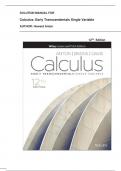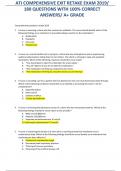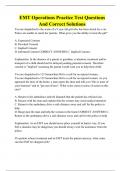SOLUTION MANUAL FOR
Calculus: Early Transcendentals Single Variable
AUTHOR: Howard Anton
12TH Edition
, Chapter 1
Functions
Exercise Set 1.1
1. (A) −2.9, −2.0, 2.35, 2.9 (B) None (C) Y = 0
(D) −1.75 ≤ X ≤ 2.15 (E) Ymax = 2.8 At X = −2.6; Ymin = −2.2 At X = 1.2
2. (A) X = −1, 4 (B) None (C) Y = −1
(D) X = 0, 3, 5 (E) Ymax = 9 At X = 6; Ymin = −2 At X = 0
3. (A) Yes (B) Yes
(C) No (Vertical Line Test Fails) (D) No (Vertical Line Test Fails)
4. (A) The Natural Domain Of F Is X ∗ =− 1, And For G It Is The Set Of All X. −1,
Whenever XF (X) = G(X), But They Have Different Domains.
(b) The Domain Of F Is The Set Of All X ≥ 0; The Domain Of G Is The Same.
5. (A) Around 1943 (B) 1960; 4200
(c) No; You Need The Year’s Population (D) War; Marketing Techniques
(E) News Of Health Risk; Social Pressure, Antismoking Campaigns, Increased Taxation
6. (A) Around 1983 (B) 1966
(C) The Former (D) No, It Appears To Be Levelling
Out
7. (A) 1999, $34,400 (B) 1985, $37,000
(C) Second Year; Graph Has A Larger (Negative) Slope
43.2 − 37.8 5.4
8. (A) In Thousands, Approximately = Per Yr, Or $900/Yr
6 6
(b) The Median Income During 1993 Increased From $37.8k To $38k (K For ’Kilodollars’; All
figures Approximate). During 1996 It Increased From $40k To $42k, And During 1999 It
Decreased Slightly From $43.2k To $43.1k. Thus The Average Rate Of Change Measured On
January 1 Was (40 - 37.8)/3 For The first Three-Yr Period And (43.2 - 40)/3 For The Second-
Year Period, And Hence The Median Income As Measured On January 1 Increased More
Rapidly In The Second Three-Year Period. Measured On December 31, However, The Numbers
Are (42 - 38)/3 And (43.1
- 42)/3, And The Former Is The Greater Number. Thus The Answer To The Question Depends
On Where In The Year The Median Income Is Measured.
(C) 1993
9. (A) F (0) = 3(0)2 −2 = −2; F (2) = 3(2)2 −2 = 10; F (−2) = 3(−2)2 −2 = 10; F (3) = 3(3)2 −2 = 25;
√ √
F ( 2) = 3( 2)2 − 2 = 4; F (3t) = 3(3t)2 − 2 = 27t2 − 2
√ √
(B) F (0) = 2(0) = 0; F (2) = 2(2) = 4; F (−2) = 2(−2) = −4; F (3) = 2(3) = 6; F ( 2) = 2 2;
F (3t) = 1/3t For T > 1 And F (3t) = 6t For T ≤ 1.
3+1 −1 + 1 Π+
1
10. (A) G(3) = = 2; G(−1) = = 0; G(Π) = −1.1 + 1 −0.1 1
G(−1.1) = = = ;
;
3−1 −1 − Π−1 −1.1 − 1 −2.1 21
2 T2 − 1 + 1 T2
1
G(T − 1)√ = = √
(B) G(3) = 3 +T21 −=12; 1 T2=−3;
− G(−1) 2 G(Π) = Π + 1; G(−1.1) = 3; G(T2 − 1) = 3 If T2 < 2 And
√
G(T2 − 1) = T2 − 1 + 1 = |T| If T2 ≥ 2.
1
,2 Chapter 1
√ √
11. (A) X = 3 (B) X ≤ − 3 Or X ≥ 3
(c) X2 − 2x + 5 = 0 Has No Real Solutions So X2 − 2x + 5 Is Always Positive Or Always Negative. If
X = 0, Then X2 − 2x + 5 = 5 > 0; Domain: (−∞, +∞).
(D) X ∗= 0 (E) Sin X ∗= 1, So X = (2n +2 1 )Π, N = 0, ±1, ±2,...
12. (A) X ∗= −57
(b) X − 3x2 Must Be Nonnegative; Y = X − 3x2 Is A Parabola That Crosses The X-Axis At X = 0, 1
3 1 3
And
X2 −Opens Downward, Thus 0 ≤ X ≤
(c) > 0, So X2 − 4 > 0 X − > 0, X > 4; X2 − < 0 X− < 0, Thus
4
X−4 And 4 Thus Or 4 And 4
−2 < X < 2
(d) X ∗= −1 (E) Cos X ≤ 1 < 2, 2 − Cos X > 0, All X
13. (A) X ≤ 3 (B) −2 ≤ X ≤ 2 (C) X ≥ 0 (D) All X (E) All X
14. (A) X ≥ 3 (B) − 3 ≤ X ≤ 3
(C) X ≥ 0 (D) X ∗= 0 (E) X ≥ 0
2
2 2
15. (A) Breaks Could Be Caused By War, Pestilence, flood, Earthquakes, For Example.
(B) C Decreases For Eight Hours, Takes A Jump Upwards, And Then Repeats.
16. (A) Yes, If The Thermometer Is Not Near A Window Or Door Or Other Source Of Sudden
TemperatureChange.
(B) No; The Number Is Always An Integer, So The Changes Are In Movements (Jumps) Of At
LeastOne Unit.
17. h 18. T
t t
19. (A) X = 2, 4 (B) None (C) X ≤ 2; 4 ≤ X (D) Ymin = −1; No Maximum Value
20. (A) X=9 (B) None (C) X ≥ 25 (D) Ymin = 1; No Maximum Value
21. The Cosine Of Θ Is (L − H)/L (Side Adjacent Over Hypotenuse), So H = L(1 − Cos Θ).
22. The Sine Of Θ/2 Is (L/2)/10 (Side Opposite Over Hypotenuse), So That L = 20 Sin(Θ/2).
23. (A) If X < 0, Then| |X =− X So F (X) = − X + 3x + 1 = 2x + 1. If X ≥ 0, Then| X| = X So
F (X) = X + 3x + 1 = 4x + 1;
2x + 1, X < 0
F (X) =
4x + 1, X ≥ 0
(B) If X < 0, Then |X| = −X And |X − 1| = 1 − X So G(X) = −X +1 − X = 1 − 2x. If 0 ≤ X < 1, Then
|X| = X And |X − 1| = 1 − X So G(X) = X +1 − X = 1. If X ≥ 1, Then |X| = X And |X − 1| =
X − 1So G(X) = X + X − 1 = 2x − 1;
1 − 2x, X<0
G(X) = 1, 0≤X<1
2
X − 1, X≥1
, Exercise Set 1.1 3
24. (A) If X < 5/2, Then |2x − 5| = 5 − 2x So F (X) = 3 + (5 − 2x) = 8 − 2x. If X ≥ 5/2, Then
|2x − 5| = 2x − 5 So F (X) = 3 + (2x − 5) = 2x − 2;
8 − 2x, X < 5/2
F (X) =
2x − 2, X ≥ 5/2
(B) If X < −1, Then |X − 2| = 2 − X And |X + 1| = −X − 1 So G(X) = 3(2 − X) − (−X − 1) = 7 −
2x. If −1 ≤ X < 2, Then |X − 2| = 2 − X And |X + 1| = X +1 So G(X) = 3(2 − X) − (X + 1) =
5 − 4x. If X ≥ 2, Then |X − 2| = X − 2 And |X + 1| = X + 1 So G(X) = 3(X − 2) − (X + 1) =
2x − 7;
7 − 2x, X < −1
G(X) = 5 − 4x, −1 ≤ X < 2
2x − 7, X≥2
25. (A) V = (8 − 2x)(15 − 2x)X 100
(B) 0 ≤ X ≤ 4
(C) 0 ≤ V ≤ 91
(D) As X Increases, V Increases And Then Decreases; The
Maximum Value Could Be Approximated By Zooming In
On The Graph.
0 4
0
26. (A) V = (6 − 2x)2x 20
(B) 0 < X < 3
(C) 0 < V < 16
(D) A X Increases, V Increases And Then Decreases; The
Maximum Value Occurs Somewhere On 0 < X < 3,
And Can Be Approximated By Zooming With A
Graphing Calculator. 0 3
0
27. (A) The Side Adjacent To The Building 28. (A) X = 3000 Tan Θ
Has Length X, So L = X + 2y. (b) Θ ∗= Nπ + Π/2 For Any Integer N,
(B) A = Xy = 1000, So L = X + −∞ < N < ∞
2000/X. (c) 3000 Ft
(C) All X = 0 6000
120
20 80 0 6
80 0
(D) L ≈ 89.44 Ft
500
29. (A) V = 500 = Πr2h So H = . Then 7
Πr2
500
C = (0.02)(2)Πr2 + (0.01)2πrh = 0.04πr2 + 0.02πr
Πr2
10
= 0.04πr2 + ; Cmin ≈ 4.39 Cents At R ≈ 3.4 Cm,
r
H ≈ 13.8 Cm
1.5 6
4






